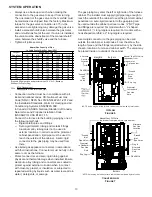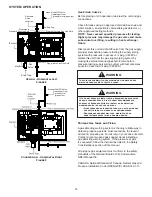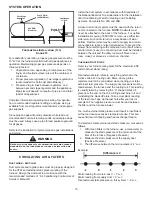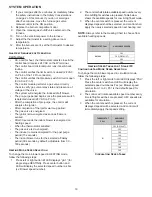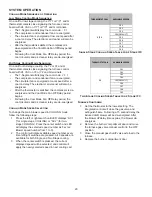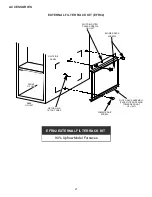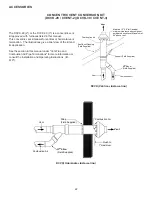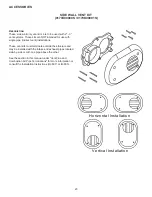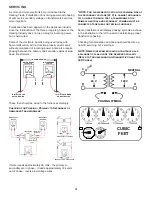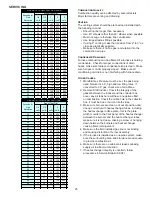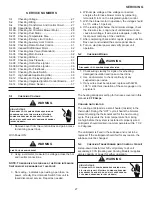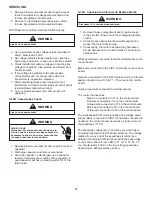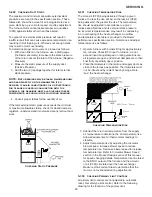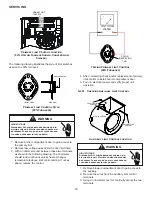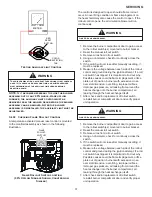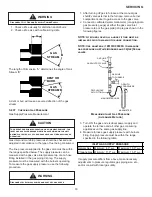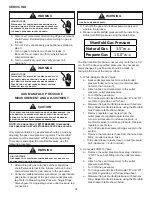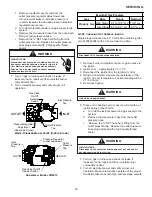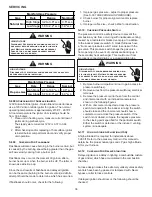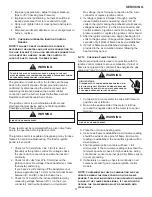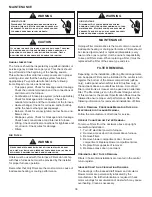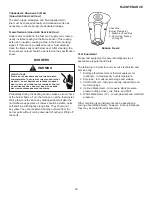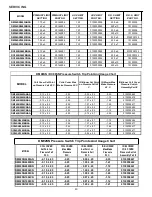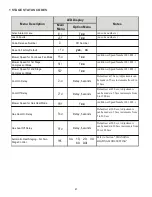
27
SERVICE NUMBERS
Checking Voltage..................................................27
Checking Wiring....................................................27
Checking Transformer And Control Circuit...........27
S-10B Capacitance Check..............................................28
S-16A Checking Air Circulator Blower Motor...................28
S-200 Checking Duct Static............................................29
S-201 Checking Temperature Rise.................................29
S-300 Checking Primary Limit Control............................29
S-301 Checking Auxiliary Limit Control...........................30
S-302 Checking Flame Rollout Control...........................31
S-303 Induced Draft Blower Motor..................................32
S-304 Checking Gas Valve (Redundant)........................32
S-305 Checking Main Burners........................................32
S-306 Checking Orifices..................................................32
S-307 Checking Gas Pressure........................................33
S-308 Checking Hot Surface Ignitor................................36
S-308A Checking Hot Surface Ignitor................................36
S-309 Checking For Flashback.......................................36
S-310 Checking Pressure Switch....................................36
S-311 High Altitude Application (USA)............................36
S-312 Checking For Delayed Ignition.............................36
S-313 Checking Integrated Ignition Control Boards........37
S-314 Checking Flame Sensor.......................................37
S-1
Checking Voltage
WARNING
HIGH VOLTAGE
Disconnect ALL power before servicing or
changing any electrical wiring. Multiple
power sources may be present. Failure to
do so may cause property damage, personal
injury or death.
1. Remove cover from the Junction Box and gain access
to incoming power lines.
With Power ON:
WARNING
Line Voltage now present.
2. Using a voltmeter, measure the voltage across the hot
and neutral connections.
NOTE: To energize the furnace, the Door Interlock
Switch must be engaged at this point.
3. No reading - indicates open wiring, open fuse, no
power, or faulty Door Interlock Switch from unit to
fused disconnect service. Repair as needed.
4. With ample voltage at line voltage connectors,
energize the furnace blower motor by jumpering
terminals R to G on the integrated ignition control.
5. With the blower motor in operation, the voltage should
be 115 volts ± 10 percent.
6. If the reading falls below the minimum voltage, check
the line wire size. Long runs of undersized wire can
cause low voltage. If wire size is adequate, notify the
local power company of the condition.
7. After completing check and/or repair, replace Junction
Box cover and reinstall the service panel doors.
8. Turn on electrical power and verify proper unit
operation.
S-2
Checking Wiring
WARNING
Disconnect ALL power before servicing.
1. Check wiring visually for signs of overheating,
damaged insulation and loose connections.
2. Use an ohmmeter to check continuity of any
suspected open wires.
3. If any wires must be replaced, replace with AWM,
105°C. 2/64 thick insulation of the same gauge or its
equivalent.
The heating anticipator setting for furnaces covered in this
manual is
0.70 Amps
.
Cooling Anticipator
The cooling anticipator is a small heater (resistor) in the
thermostat. During the “OFF” cycle it heats the bimetal
element helping the thermostat call for the next cooling
cycle. This prevents the room temperature from rising
too high before the system is restarted. A properly sized
anticipator should maintain room temperature within 1 1/2
to 2 degrees.
The anticipator is fixed in the subbase and is not to be
replaced. If the anticipator should fail for any reason, the
subbase must be changed.
S-4
Checking Transformer And Control Circuit
A step-down transformer 120 volt primary to 24 volt
secondary, 40 VA (Heating and Cooling Models) supplies
ample capacity of power for either operation.
WARNING
HIGH VOLTAGE
Disconnect ALL power before servicing or in
-
stalling this unit. Multiple power sources may
be present. Failure to do so may cause proper
-
ty damage, personal injury or death.
SERVICING

